Top News
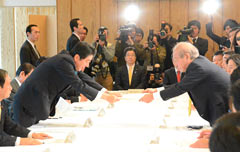
December 18, 2013 Ryukyu Shimpo
Okinawa Governor Hirokazu Nakaima called for Marine Corps Air Station Futenma to stop operating within five years at the Okinawa Policy Council meeting held in the Prime Minister’s Office on December 17. He also requested a reduction of the prefecture’s burden of bases, including the return of the Makiminato Service Area within seven years and revision of U.S.-Japan Status of Forces Agreement.
Prime Minister Shinzo Abe responded by saying that he will do all he can to meet these requests. It is the first time that the governor has requested the Futenma base to cease operating and set a deadline of within five years. However, on this occasion he did not ask the government to relocate the base outside the prefecture.
Prime Minister Abe, all his cabinet members and Okinawa Governor Nakaima attended the meeting to discuss the economic development of Okinawa and U.S. military base issues.
Government officials explained their efforts to reduce the burden of bases, promoting use of the land returned from the U.S. military and 2014-tax reform. Nakaima noted that improving the operation of the current Status of Forces Agreement is not necessarily a realistic way to resolve issues. He suggested that before the land is returned the government should carry out investigations in the bases, including environmental measurement-while-drilling and added that stricter environmental standards should be applied. He requested that the Osprey aircraft on the Futenma base be moved outside of Okinawa as well as the majority of the training programs. He indicated a willingness to fit in with the government’s security policy, saying, “I want to contribute to the stability and development of the Asia-Pacific region.”
He said that the government’s development programs could lift Okinawa up to the level of the other prefectures, but that support is still needed for a while yet. He requested the introduction of a railway to the main island and that 340.8 billion yen be allocated in the next fiscal year’s budget for the development of Okinawa.
After the meeting, the governor spoke to reporters about the timing of his decision to approve or reject the application for the Henoko landfill. Again indicating that he wants to settle things by the end of December, he said, “It might just sneak in before the end of the year.” He went on to stress that his earlier thinking has not changed. “I never said that I’ve given up on relocating it ‘outside the prefecture.’ It would be more time consuming and involve greater effort to move the base to Nago. I still think it would be quicker to move the base out of Okinawa.”
Chief Cabinet Secretary Yoshihide Suga said in the press conference, “We will adhere to our basic position that we want to make every effort for Okinawa Prefecture.”
(English translation by T&CT, Mark Ealey)
Go to Japanese
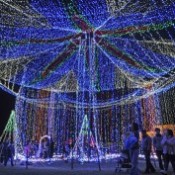
December 15, 2013 Ryukyu Shimpo
The 15th Itoman Peace Illumination started at the Itoman Tourist Farm in Mabuni, Itoman on December 14. This year’s theme is the prayer of light to connect people. About 300,000 lights were lit up at the same time.
The lights are on from 6.00pm to 10.00 p.m. and until midnight on December 31.
Itoman Mayor Hirotsune Uehara, the head of the executive committee of the event, said, “We would like the event to contribute to creating a peaceful world.”
The Peace Illumination event will run until January 3, 2014. The admission fee for high school students and adults is 250 yen, but children of junior high school age or younger enter for free. The venue opens at 5:30 p.m. There are fireworks displays on December 25 and 30.
For further details, call the executive committee at 098 (840) 8135.
(English translation by T&CT, Mark Ealey)
Go to Japanese
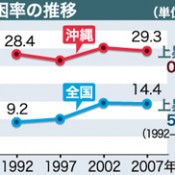
December 15, 2013 Ryukyu Shimpo
The poverty rate of Okinawa in 2007 was 29.3 percent, the highest in Japan and twice the national average of 14.4 percent. Associate professor of Yamagata University Kensaku Tomuro revealed the results of his survey of poverty rates by prefecture on December 14. The working-poor rate for Okinawa was 20.5 percent, the highest in Japan and three times the national average of 6.7 percent. The welfare-recipient rate for Okinawa was 9.8 percent, which is 4.5 percent lower than the national average of 14.3 percent.
Tomuro carried out the survey from 1992 to 2007 with the values representing those five years.
The number of full-time workers in Japan has drastically decreased since 1998, with amendments to the Worker Dispatch Act in 1999 also impacting upon the working environment. This has led to higher poverty rates nationwide, but poverty indicators in Okinawa have been consistently high, something which is peculiar to Okinawa.
While the poverty rate in Okinawa is high, its welfare-recipient rate was under 10 percent at 9.8 percent of those eligible. The prefecture’s constantly high poverty rate and low welfare-recipient rate makes Okinawa one of the poorest areas in Japan.
The latest survey carried out in 2009 by the Ministry of Health, Labor and Welfare gives a nationwide poverty rate of 16 percent, with the child poverty rate at 15.7 percent.
Tomuro said that this is the first time that researchers have surveyed the working poor rate by prefecture. It is also the first time that they have carried out a survey giving trends in poverty rate by prefecture from the beginning of the 1990s to the 2000s.
(English translation by T&CT, Mark Ealey)
Go to Japanese
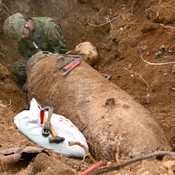
December 13, 2013 Ryukyu Shimpo
At about 12:40 p.m. on December 12, workers carrying out a magnetic survey found a one-ton bomb in an uninhabited area of Kyan in Itoman. Experts speculate that the piece of unexploded ordnance found buried about one meter below the ground was a U.S. made bomb. It measures about 60 cm in diameter and is about 180 cm long. The spot is located about 230 meters to the east of the Okinawa Prefectural Fisheries Research and Extension Center, but there are no houses anywhere near the scene. Ground Self-Defense Force Garrison personnel based in Naha stated that there were two fuzes and explosive powder inside the bomb.
The Disaster Prevention and Crisis Management Division of the Okinawa Prefectural Government also commented on the find. They said that this is the first time that a piece of unexploded ordnance in the one-ton class has been found for 23 years, since April 1990. It is also the sixth case since 1972, the year that the U.S. government returned the islands to Japan. The GSDF bomb disposal squad will remove the fuses from the piece of unexploded ordnance and then take it from the field. The date and time that this will happen has not been determined yet.
(English translation by T&CT, Mark Ealey)
Go to Japanese

December 12, 2013 Ryukyu Shimpo
Astronomer Yuko Kakazu delivered a lecture to students of Okinawa Shogaku High School using a TV phone from the Subaru Telescope of the National Astronomical Observatory of Japan in Hawaii. A total of 63 first to third grade students of the International Culture and Science course took part in the class held on December 6. Kakazu’s lecture was titled “The Travels of an Uchinanchu astronomer: My 6,000-mile journey and 13-years of dreaming about the universe.” A former student of the school, after studying in the United States she has been involved in astronomical research in France and Hawaii. Based on her experience abroad, she told the students how wonderful it would be if they were to work abroad. She said, “By spending time with people from different countries and understanding the diverse values those people have you come to develop an objective view of Japan.”
Several countries have observatories on Mauna Kea in Hawaii. Kakazu explained why it is such an ideal location, saying, “Because the islands are so far away from land the air is constantly flowing, making it clean.” She explained about the latest developments with new observatories and showed them an 18th century star map from Ishigaki-jima.
Kakazu encouraged the junior students, saying, “The world is a big place. The universe is even bigger still. Try not to put a lid on your potential.”
Rizu Iriomote, a first-grade student who had just recently transferred from Ishigaki-jima, said, “Kakazu-san is fantastic. She’s got a global vision and is still pursuing her dreams.” Soshi Nobu, a first-grade student, said, “I am proud that someone like Kakazu-san has been to our school.”
Noriko Bousckri, who is in charge of the International Cultural Science course, summed up the motivation behind the lecture. She said, “We want the students to go abroad to understand where Okinawa stands in the world and to think about the Okinawa of the future.”
(English translation by T&CT, Mark Ealey)
Go to Japanese
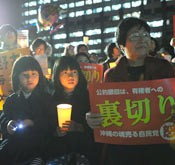
December 11, 2013 Ryukyu Shimpo
The U.S. and Japanese governments plan to move U.S. Marine Corps Air Station Futenma to Henoko in Nago, where they will reclaim land to build the new base. At the Public Square in Naha on December 10, 500 people, mainly women, gathered to ask Okinawa Governor Hirokazu Nakaima to reject the application to reclaim the land.
According to the organizer, 74 female organizations took part in the gathering. The participants called for the governor to uphold his pledges to the public to reject the plan to reclaim the land.
Each protesting in their own way, some lit candles they had made themselves and others carried placards.
Chikako Toguchi, who represents one of the organizations, delivered a speech. She said, “We don’t want U.S. military bases anywhere in Okinawa. Our pride is being tested here. Let’s stand up and protest and make our children proud of us.”
(English translation by T&CT, Mark Ealey)
Go to Japanese
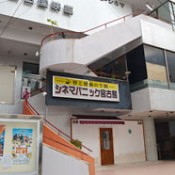
December 11, 2013 Ryukyu Shimpo
Digitalization has affected many movie theaters. Now on the verge of closing, Cinema Panic Miyakojima has been the only theater in the Miyako area in Japan’s extreme south to contribute to cinema culture. It would cost 10 million yen to convert it to a digital system. This is a figure the theater cannot cover by itself, so on December 10 it started raising money.
The head of the theater, Masanobu Shimoji, said, “I would like people out there to help us keep the theater going by donating towards the cost of the digitalization.”
Cinema Panic Miyakojima opened in 2005 after refurbishing the old Miyako Kokueikan theater. Since then the new theater has screened a diverse range of films.
Production of film came to an end last September. After that, the movie industry rapidly switched to digital data, making it difficult for the theater to screen movies that will attract large audiences. In these difficult circumstances, the theater heard that several small theaters in other parts of Japan had started raising money to convert to a digital cinema system. It decided to do the same, aiming to raise 10 million yen to buy and maintain a digital system.
When he was just a junior high school student, Ryugo Nakamura directed the film Yagi no bouken (The Catcher on the Shore) and screened it in the theater. Nakamura will assist in creating a promotional video to help raise the money they need. In addition, the theater will collect messages of support from Miyako citizens and well-known figures and display them. Shimoji said, “I want this project to succeed so we can keep our passion for movies alive on Miyako-jima.”
The theater will accept the donations until the end of March, 2014.
It plans to put 100 collection boxes in the theater and at convenience stores around the city.
For further details, call Cinema Panic Miyakojima at 098 (075) 3215 or access its website at http://zumi-miyako.com/cp/index.html.
The bank account details for donations are as follows:
Okinawa Bank Miyako Branch/branch code: 501, checking account: 2094752 (Masanobu Shimoji, President of Cinema Panic Miyakojima Limited)
Japan Post Bank/code:17040, number:10488971 (Cinema Panic Miyakojima Limited)
(English translation by T&CT, Mark Ealey)
Go to Japanese
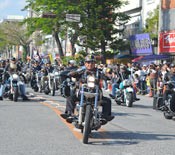
December 5, 2013 Ryukyu Shimpo
On December 1, the Gate #2 Festa was held in front of Kadena Air Base in Koza Gate Street, which is also known as Kuko-dori.
Starting at 2:00 p.m. and attracting a large crowd, the parade of more than 300 motorcycles was the main event of the festival. Spectators on the sidewalk cheered as the starter pistol set 500 meters of motorcycles moving with their deep bass engine sound.
Harley-Davidsons, crotch rockets, classics and other motorcycles polished by enthusiasts filled Gate 2 Street for about 30 minutes. Fans took photographs and videos of the parade.
There were also events including live music performances and arm wrestling.
(English translation by T&CT, Hitomi Shinzato and Mark Ealey)
Go to Japanese
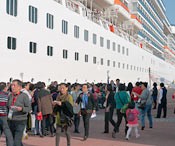
December 6, 2013 Ryukyu Shimpo
The charter cruise ship the Costa Atlantica (about 85,000 tons), carrying 2,389 Chinese tourists, called at Naha Port on December 5. Visits by Chinese charter cruise ships were cancelled when the Senkaku Islands dispute occurred, so this is the first visit in a year and five months.
The Costa Atlantica is an Italy-flagged vessel owned by the Costa Cruises Company.
A woman from Zhejiang who came with three friends said, “This is my first cruise to Okinawa. I have heard that it is known as the Hawaii of Asia. The air is nice and fresh. We will visit tourists spots like Manzamo.”
(English translation by T&CT, Mark Ealey)
Go to Japanese

December 4, 2013 Ryukyu Shimpo
Yanbaru Harusaa’s Table Kaito+, a cafe located within the Okinawa Institute of Science and Technology (OIST), has won the excellence award in the sales and consumer promotion section of Food Action Nippon 2013. Food Action Nippon is a project designed to recognize business organizations and individuals who contribute to the improvement of food self-sufficiency. The award ceremony was held on December 3 in Tokyo.
Kaito+ is a cafe jointly operated by bakery Pain de Kaito and the farming corporation Cooksonia in Nago. By serving local produce, its vegetarian menu conveys the charm of vegetables produced in the Yambaru area to overseas researchers at OIST. Kaito+ also sells vegetables at the cafe and uses items that remain in side dishes in an attempt to reduce waste to zero. It also helps provide farmers with stable revenue by buying their produce. They encourage local farmers to plant sweet herbs such as coriander, which in turn helps to expand the variety of produce that the farmers grow.
Kyoko Ishida, manager of the Kaito + said, “We also sell ingredients that researchers from Southeast Asia cannot easily get, so both Japanese and foreigners are happy.” Shinya Koizumi, a member of the Cooksonia staff points out a ripple effect, saying, “We can have a go at producing a wide variety of things. Stores that use these new vegetables in the region have also appeared. The link between the farmers and the restaurants has become stronger.”
(English translation by T&CT, Mark Ealey)
Go to Japanese
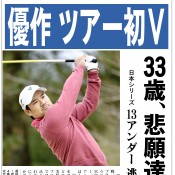
December 9, 2013 Ryukyu Shimpo
Yusaku Miyazato has won his long-sought-after first title in his 11-year career as a professional in the season-ending Nippon Series JT Cup. The final round of the JT Cup was held on December 8 at the Tokyo Yomiuri Country Club.
The first-round co-leader with other three players including Yoshinori Fujimoto, Miyazato assumed second place in the second round only one stroke behind the leader. In the third round he regained the top position. In the end he won the title in 267 strokes (13 under par), three shots ahead of China’s Ashun Wu. Miyazato received 40 million yen in prize money for the win and moved up to seventh place in this season’s money rankings.
Miyazato turned professional in 2002, after winning the Japan Amateur Championship as well as three consecutive Japan Student Golf Championships.
Originally from Higashi Village, 33 year-old Miyazato is the older brother of LPGA player Ai Miyazato.
(English translation by T&CT, Mark Ealey)
Go to Japanese











 Webcam(Kokusai Street)
Webcam(Kokusai Street)


